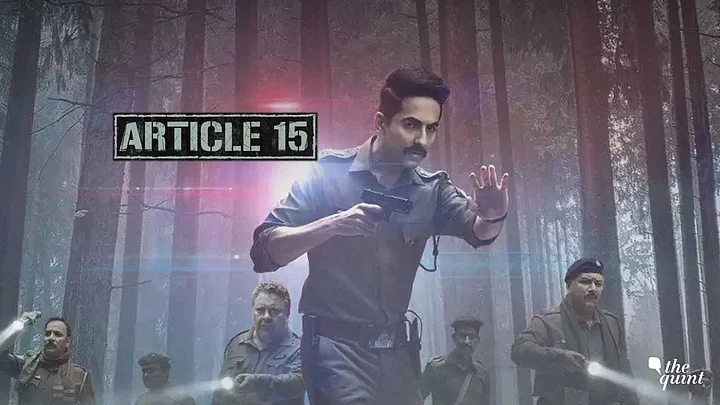The most powerful scene in Article 15 is one sans dialogue.
Ewan Mulligan’s camera stays steady as we see a man push himself up from a filthy, clogged drain. His expression is unfathomable as he is covered with an almost black slimy liquid. As he ducks again to remove more garbage, the man becomes invisible, but this image is stark – as unforgettable as it is unforgivable.
The garbage and overflowing gutters outside the police chowki are a physical manifestation of the rut that runs deep in the system. Even in 21st century India, manual scavenging is a grim reality – one that Bollywood has finally become brave enough to depict.
For the uninitiated, Article 15 of our Constitution states that “the State shall not discriminate on the basis of religion, race, caste, sex or place of birth.”
Article 15 Doesn’t Shy Away from Murky Malfeasance
In that sense, the film is a simple and straightforward social commentary on the iniquitous practice of caste discrimination. Article 15 doesn’t shy away from going into the murky malfeasance of upper caste hegemony and the social injustice so rampant that both the victim and the perpetrator have internalised it unquestioningly.
It is this attitude that makes our IPS hero Ayan Ranjan describe his new posting in Lal Gaon as the “wild wild West.”
With an education from St Stephen’s and having recently returned from abroad, he seems completely flummoxed by what he sees around. In a particularly telling scene, a group of police officers when being questioned about their caste readily furnish the information.
One is a Chamar, another a Pasi, and one is a Jat, who says he was “normal” earlier but now is an OBC.
Kayasts don’t belong to the four varnas, and we are told that even the upper caste Brahmins have sub-sections. The scene on its surface seems tongue-in-cheek, till a darker tone is revealed.
These are people whose sense of identity comes from their caste awareness and their whole world view is fashioned by it. As flabbergasted as officer Ayan Ranjan might be, it is exactly this that he must negotiate for there to be any hope of justice.
In a grim reminder of the 2014 Badaun gang rape and murder of two young girls found hanging from a tree, the film depicts the various forces at play to protect the perpetrators and further marginalise the victims.
It is the taut screenplay by director Anubhav Sinha and co-writer Gaurav Solanki that lends such depth of insight to the narrative that the film shines despite its determined eagerness not to.
Article 15 Prods us to Think & Question
The film benefits immensely from its perfect casting. Ayushmann Khurrana as the earnest and sincere police officer, Mohammed Zeeshan Ayyub as the charismatic voice of the down-trodden and the terrific ensemble caste comprising Sayani Gupta, Kumud Mishra, Manoj Pahwa, Ronjini chakrabarty, Ashish Verma, Isha Talwar all are fabulous and irrepressible.
Khurrana and his telephonic correspondence with his wife – played by Isha Talwar, who in so many ways is his conscience keeper and confidante – helps us decode what really goes on in his mind.
It all comes down to keeping the book of law above all prejudice and bias.
Article 15 is a simple yet powerful statement on faith and inclusivity. However, it is not simplistic in its portrayal of a layered social reality.
It prods us on to think, question, reflect and makes us a little uncomfortable with the status quo – just as powerful cinema often does. Make time for it. I would go with 4 Quints out of 5!
(At The Quint, we question everything. Play an active role in shaping our journalism by becoming a member today.)
